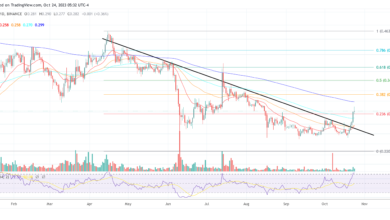As Ethereum moves closer to $2k, this metric sees 8-month high

- Ethereum’s Taker Buy-Sell Ratio sat at its highest level since February.
- At 1.003 at press time, ETH’s Buy Volume exceeded its sell volume in the Futures market.
Ethereum’s [ETH] Taker Buy-Sell Ratio, assessed on a 30-day simple moving average (SMA), has climbed to its highest level since 2 February, data from CryptoQuant revealed.
How much are 1,10,100 ETHs worth today?
The Taker Buy-Sell Ratio is a metric that measures the ratio between the buy volume and sell volume in an asset’s Futures market. A value greater than 1 indicates more buy volume than sell volume, while a value less than 1 indicates more sell volume than buy volume.
Due to the significant resistance faced by ETH at the $2000 price level since April, its Taker Buy-Sell Ratio trended downward since 29 May. By 22 August, this had fallen to its lowest level this year.
As market sentiment improved towards the end of September, ETH’s Taker Buy-Sell Ratio initiated a correction and began to ascend on 15 September. The metric reclaimed its center line a month later and continued its upward trend.
At press time, ETH’s Taker Buy-Sell Ratio was 1.003, data tracked by CryptoQuant showed.

Source: CryptoQuant
According to pseudonymous CryptoQuant analyst Greatest Trader:
“This surge signifies a prevalent bullish sentiment in the Futures market. This upward trend aligns seamlessly with Ethereum’s recent impulsive surge, propelling it toward the $1.7K resistance level.”
At press time, ETH exchanged hands at $1,825. According to CoinMarketCap, this represented the altcoin’s highest price level since 17 August. In the last 24 hours, ETH’s value has grown by almost 10%, and in the last week, by 15%.
Warning of a potential retracement in ETH’s value, the CryptoQuant analyst opined:
“However, given the significant surge in this metric, it is anticipated that the market might require a temporary pause in the trend. This pause could lead to a short-term correction stage before the market initiates another substantial upward movement. In the upcoming days, it’s crucial to observe if the ratio maintains this momentum or reverses. If the bullish momentum wanes, it could potentially lead to increased market volatility.”
Volatility markers climb to multi-month highs
An assessment of a few volatility markers on the ETH’s daily chart confirmed that the increased activity around the altcoin in the last month has increased the possibility of severe price fluctuations.
For example, its Average True Range (ATR) – which measures market volatility by calculating the average range between high and low prices over a specified number of periods – was spotted at 54.52 at press time. This was the indicator’s highest level since 20 July.
When ATR surges in this manner, it suggests that the price swings are becoming more significant.
Likewise, ETH’s Chaikin Volatility indicator has trended upward since 15 October to be pegged at 55.92 at press time, its highest level since the end of August.
This indicator measures the difference between an asset’s high and low prices over a specified period. Generally, when the Chaikin Volatility indicator rallies to return higher values, it signals significant price movements and potential volatility.
Is your portfolio green? Check out the ETH Profit Calculator
Lastly, ETH’s rising Bollinger Bandwidth (BBW) confirmed the presence of volatility in the alt’s market. As of this writing, this indicator returned a value of 0.18.
These volatility markers hint at very low stability in the ETH market. The coin’s price remains prone to severe fluctuations and can initiate a descent should bullish momentum begin to wane.

Source: ETH/USD on TradingView





